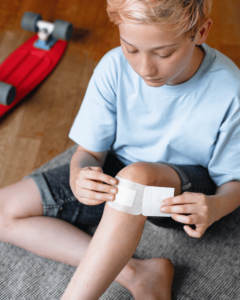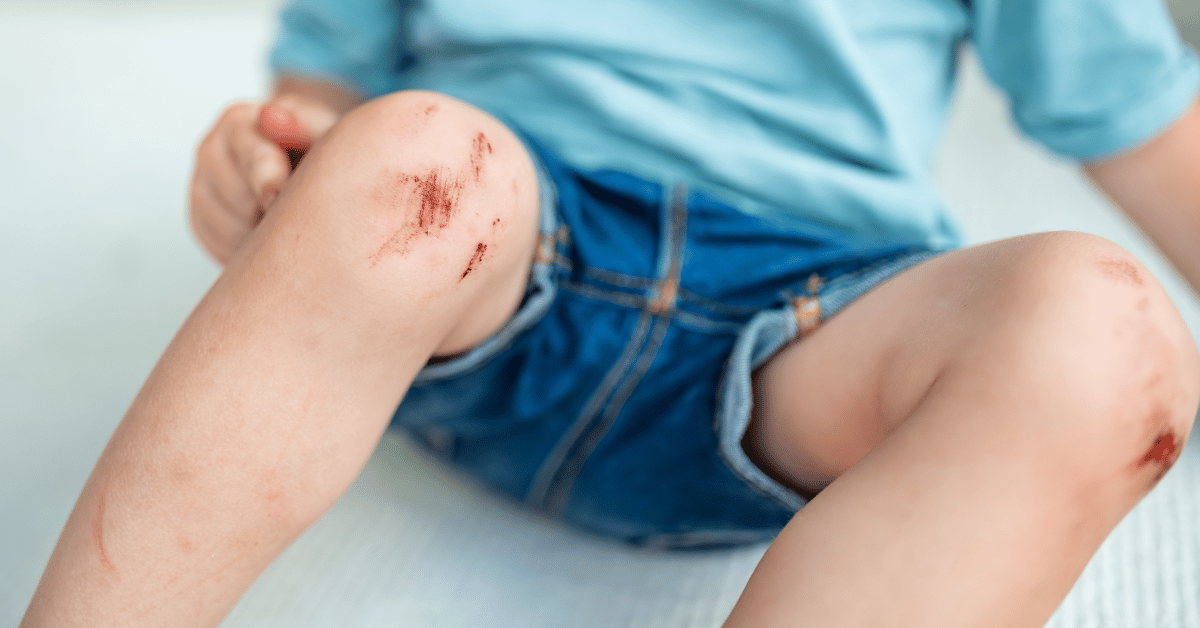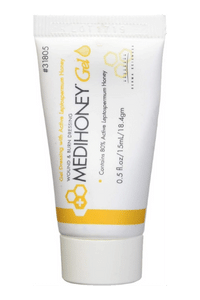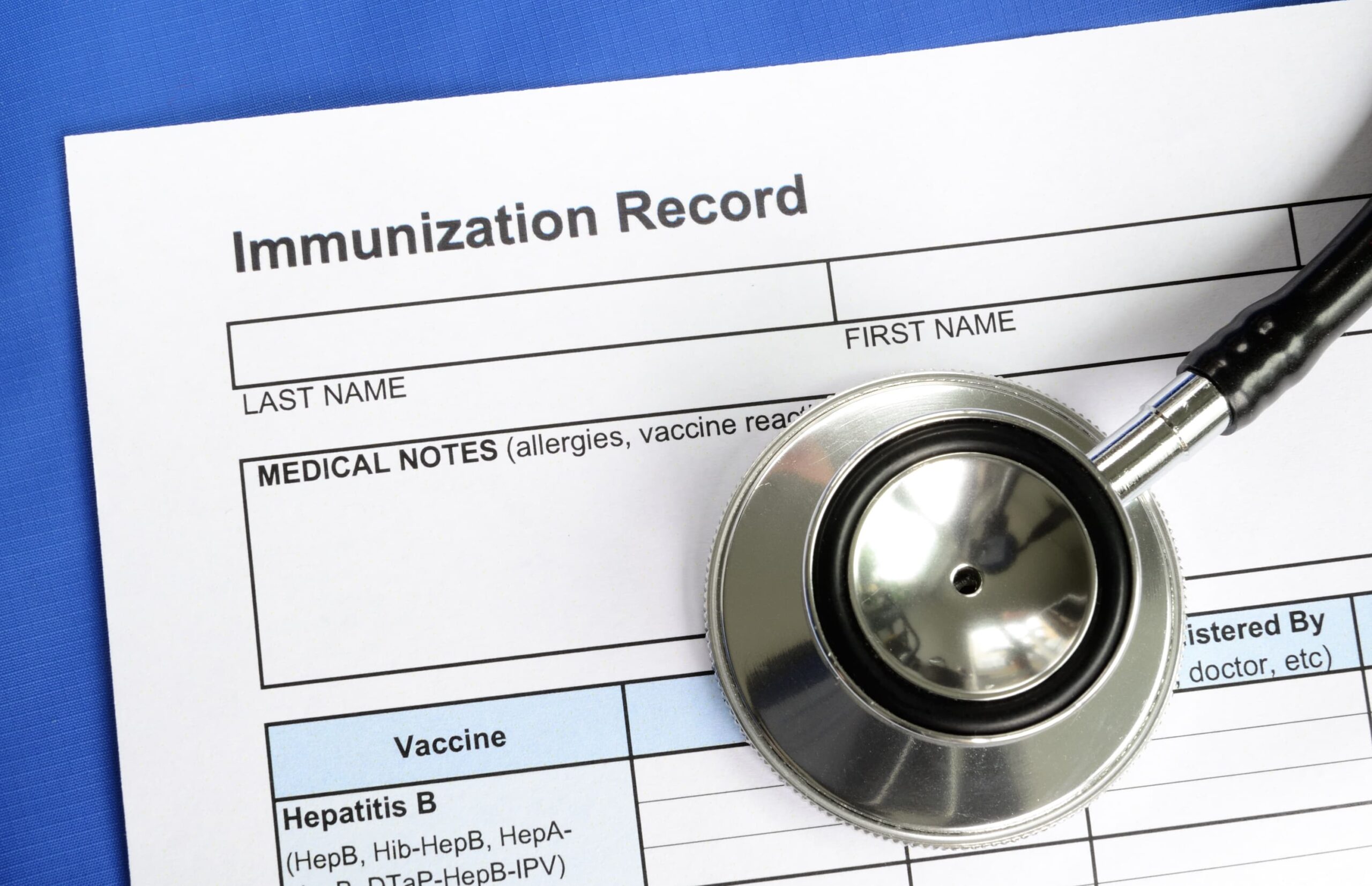A basic knowledge of how to clean minor cuts and scrapes is important for parents, especially if you have active and adventurous kids. While the little cuts and scrapes of childhood are typically not serious, proper care is essential to prevent infection and promote healing.
This article covers best practices for cleaning minor cuts and scrapes, when to seek medical attention, and potential signs of infection; it also compares various antiseptics and healing ointments.
How To Clean Minor Cuts & Scrapes
When cleaning a cut or scrape, the first step is to wash your hands with soap and water so that they don’t introduce bacteria or dirt into the wound. Next gently clean the cut or scrape under running water for several minutes to remove any visible dirt or debris.
 If running water isn’t available, you can use clean water from a water bottle. Avoid using soap during this step, as it can cause unnecessary irritation. When tending to kids with minor cuts and scrapes, take things slow and explain what you are doing.
If running water isn’t available, you can use clean water from a water bottle. Avoid using soap during this step, as it can cause unnecessary irritation. When tending to kids with minor cuts and scrapes, take things slow and explain what you are doing.
Note: If there’s anything embedded in the wound, do not try to remove it; instead seek medical advice. If there are small bits of debris that can’t be washed away but can be easily removed, use small tweezers that have been cleaned with 70%+ isopropyl alcohol to remove them.
How To Disinfect Cuts & Scrapes
After cleaning the area, you may wish to disinfect the wound. In my home, we usually choose not to disinfect the wound because it can cause skin irritation and delay wound healing. However, there are some cases where you may choose to disinfect a wound, such as a dirty wound. To disinfect the wound, apply a small amount of antiseptic of choice to a clean cotton swab or cloth and gently dab the area.
Pros & Cons of Antiseptics
In this section, we’ll compare the pros and cons of rubbing alcohol, hydrogen peroxide, iodine, colloidal silver solution, and chlorhexidine for disinfecting cuts and scrapes.
Rubbing Alcohol (Isopropyl Alcohol)
Rubbing alcohol is a common choice as disinfectant and antiseptic* and is used in many medical settings. It is quite effective at killing bacteria but comes with the drawbacks of stinging and being harsh on skin. It may cause skin irritation and delay wound healing. The optimal concentration is 60-90% (1).
*Disinfectants are used to kill germs on non-living surfaces, while antiseptics are used to kill germs on the body.
Hydrogen Peroxide
Hydrogen peroxide is commonly used for disinfecting minor wounds, and many people find that it stings less than rubbing alcohol, but it still causes significant discomfort. Hydrogen peroxide foams and bubbles when it destroys bacteria. Some people like to keep applying it until the foaming and bubbling stops, which is thought to indicate that all the bacteria has been killed. It is commonly thought that hydrogen peroxide causes skin irritation and delays wound healing, but more recent research refutes that position (2,3).
Povidone Iodine
Iodine is another common antiseptic that many of us are familiar with for keeping wounds clean. It has wide efficacy, is anti-inflammatory, and does not have a negative effect on wound healing. Iodine’s main drawbacks are skin staining and a potential for allergic reaction (4).
Povidone Chlorhexidine
Chlorhexidine is known to be both effective and gentle and is my preferred antiseptic at home with my family. Though it is generally quite gentle, there is the possibility of allergic reaction (1).
Colloidal Silver
Colloidal Silver is less commonly used as an antiseptic (1). Evidence shows that silver can be helpful for infected wounds but isn’t as helpful for clean wounds (5).
Note: Infected wounds should be examined by a healthcare provider.
How To Dress Minor Cuts and Scrapes
Minor cuts and scrapes should be covered with a sterile bandage until the bleeding stops. The bandage helps to stop bleeding and protect the open wound from contamination. Applying gentle pressure may help the bleeding stop more quickly.
 Opinions about whether keeping a minor wound wet or dry tend to vary over the years. With the type of small cuts and scrapes that we’re talking about, they will almost certainly heal without complication no matter if you keep them covered and wet or let them dry out completely.
Opinions about whether keeping a minor wound wet or dry tend to vary over the years. With the type of small cuts and scrapes that we’re talking about, they will almost certainly heal without complication no matter if you keep them covered and wet or let them dry out completely.
In my opinion, and I have some research to back me up, the ideal is a goldilocks not-too-wet-not-too-dry state (6). I find that the best way to attain this moist state is to use a wound healing ointment before applying the bandage.
How To Apply A Wound Healing Ointment To Minor Cuts and Scrapes
Most minor cuts and scrapes don’t require wound healing ointment, but you may wish to use one because of the benefits that they offer.
Possible benefits of wound healing ointments include pain relief, protection from infection, and improved skin healing.
To apply a wound healing ointment, again make sure that your hands are clean. Apply a small amount directly on top of the wound, close beside it, or on the part of the bandage that will be touching the wound.
Pros & Cons Of Wound Healing Ointments
In this section, we’ll compare the pros and cons of triple antibiotic ointment, botanical ointments, plain petroleum jelly, and honey dressings for healing from minor cuts and scrapes.
Triple Antibiotic Ointment
Triple antibiotic ointment is a common choice for family first-aid kits. It consists of neomycin, polymyxin B, and bacitracin in a petroleum base. Some formulations also contain lidocaine to help with pain. This ointment works by stopping the growth of organisms, which makes it effective at preventing infections but not clearing them (7). This ointment is in a base of petroleum jelly which has pros and cons of its own, see below.
Botanical Ointments
I prefer a botanical wound healing ointment for my family. Herbs may be selected for their abilities to kill bacteria, enhance wound healing, and help with pain. The botanical that I always look for in healing ointments is calendula, though there are many other helpful plants in this category (8).
Petroleum Jelly
While researching this article, I came across recommendations from the American Academy of Dermatology Association. It is the first time that I’ve seen plain petroleum jelly recommended as a wound healing ointment for small cuts and scrapes. The benefit of petroleum jelly is that it keeps the wound moist, has very low allergenic potential, and is recommended by dermatologists, the doctors who arguably know most about healing skin. The main drawback of petroleum jelly is the chance of contamination with polycyclic aromatic hydrocarbons, which are associated with health problems such as cancer (9).
Honey Dressings
Honey dressings are helpful for preventing infection and speeding healing, but they can be a little messy in my experience. Though regular honey can be helpful, Manuka honey contains special properties that make it superior (10). There is also evidence that mixing colloidal silver with honey improves its efficacy, as does mixing honey with black cumin seed oil (11). Be sure when choosing honey for a wound dressing that it is pure and suitable for medicinal use (11). I like the MEDIHONEY gel that comes in a tube and can be applied like any of the above ointments.
When To See A Doctor For Minor Cuts And Scrapes
Medical care is rarely needed for the minor cuts and scrapes of childhood. You can expect them to heal completely in a week or less. However, if you notice signs of infection (pus, increased and/or spreading redness, fever, swelling, pain, red streaks extending from area), medical care is needed.
When to seek urgent medical care:
- Cut longer than ¾ inch
- Cut deeper than ¼ inch
- Cut won’t stop bleeding
- Embedded objects in the cut
Tetanus: An Important Consideration
Though it is important to prevent infection in general, one of the most feared and serious infections is tetanus. Tetanus is a vaccine-preventable bacterial infection caused by Clostridium tetani. Symptoms include muscle stiffness, difficulty swallowing, and severe muscle spasms. It is estimated that there are 1,000,000 tetanus cases worldwide resulting in 200,000 deaths (12).
The tetanus vaccine is considered very effective in preventing tetanus (13), but rare breakthrough cases are still possible (14). The tetanus vaccine needs to be boosted every ten years (15).
Tetanus is most common after deep penetrating wounds that are contaminated with soil, dust, or feces. However, even minor trauma can lead to tetanus (16).
This underscores the need for good care and cleaning of wounds and prompt medical attention for wounds that appear infected. It also speaks to the benefits of the tetanus vaccine.
Note: If you’re on the fence about your child receiving the tetanus vaccine, or others, check out our Vaccine Strategy Guide.
Summary
Proper care of minor cuts and scrapes is simple but necessary in order to prevent infection and support healing. The most important steps are cleaning the wound with water and dressing the wound with a sterile bandage. Disinfecting the wound with an antiseptic or applying healing ointment are optional steps. See a doctor for serious cuts and scrapes or if there are signs of infection.
References:
- Atiyeh BS, Dibo SA, Hayek SN. Wound cleansing, topical antiseptics and wound healing. Int Wound J. 2009 Dec;6(6):420-30. doi: 10.1111/j.1742-481X.2009.00639.x. PMID: 20051094; PMCID: PMC7951490.
- Murphy EC, Friedman AJ. Hydrogen peroxide and cutaneous biology: Translational applications, benefits, and risks. J Am Acad Dermatol. 2019 Dec;81(6):1379-1386. doi: 10.1016/j.jaad.2019.05.030. Epub 2019 May 16. PMID: 31103570.
- Zhu G, Wang Q, Lu S, Niu Y. Hydrogen Peroxide: A Potential Wound Therapeutic Target? Med Princ Pract. 2017;26(4):301-308. doi: 10.1159/000475501. Epub 2017 Apr 5. PMID: 28384636; PMCID: PMC5768111.
- Bigliardi PL, Alsagoff SAL, El-Kafrawi HY, Pyon JK, Wa CTC, Villa MA. Povidone iodine in wound healing: A review of current concepts and practices. Int J Surg. 2017 Aug;44:260-268. doi: 10.1016/j.ijsu.2017.06.073. Epub 2017 Jun 23. PMID: 28648795.
- Khansa I, Schoenbrunner AR, Kraft CT, Janis JE. Silver in Wound Care-Friend or Foe?: A Comprehensive Review. Plast Reconstr Surg Glob Open. 2019 Aug 12;7(8):e2390. doi: 10.1097/GOX.0000000000002390. PMID: 31592393; PMCID: PMC6756674.
- Nuutila K, Eriksson E. Moist Wound Healing with Commonly Available Dressings. Adv Wound Care (New Rochelle). 2021 Dec;10(12):685-698. doi: 10.1089/wound.2020.1232. Epub 2021 Feb 11. PMID: 32870777; PMCID: PMC8568799.
- Bonomo RA, Van Zile PS, Li Q, Shermock KM, McCormick WG, Kohut B. Topical triple-antibiotic ointment as a novel therapeutic choice in wound management and infection prevention: a practical perspective. Expert Rev Anti Infect Ther. 2007 Oct;5(5):773-82. doi: 10.1586/14787210.5.5.773. PMID: 17914912.
- Albahri G, Badran A, Hijazi A, Daou A, Baydoun E, Nasser M, Merah O. The Therapeutic Wound Healing Bioactivities of Various Medicinal Plants. Life (Basel). 2023 Jan 23;13(2):317. doi: 10.3390/life13020317. PMID: 36836674; PMCID: PMC9960863.
- Mackerer CR, Griffis LC, Grabowski JS Jr, Reitman FA. Petroleum mineral oil refining and evaluation of cancer hazard. Appl Occup Environ Hyg. 2003 Nov;18(11):890-901. doi: 10.1080/10473220390237467. PMID: 14555442.
- Molan P, Rhodes T. Honey: A Biologic Wound Dressing. Wounds. 2015 Jun;27(6):141-51. PMID: 26061489.
- Tashkandi H. Honey in wound healing: An updated review. Open Life Sci. 2021 Oct 6;16(1):1091-1100. doi: 10.1515/biol-2021-0084. PMID: 34708153; PMCID: PMC8496555.
- Ergonul O, Egeli D, Kahyaoglu B, Bahar M, Etienne M, Bleck T. An unexpected tetanus case. Lancet Infect Dis. 2016 Jun;16(6):746-752. doi: 10.1016/S1473-3099(16)00075-X. PMID: 27301930.
- Rabadi T, Brady MF. Tetanus Toxoid. 2023 May 1. In: StatPearls [Internet]. Treasure Island (FL): StatPearls Publishing; 2024 Jan–. PMID: 32491347.
- Ergonul O, Egeli D, Kahyaoglu B, Bahar M, Etienne M, Bleck T. An unexpected tetanus case. Lancet Infect Dis. 2016 Jun;16(6):746-752. doi: 10.1016/S1473-3099(16)00075-X. PMID: 27301930.
- Crone VE, Uslu B, Bærentzen FØ, Holmgaard DB, Wiese L. [Tetanus in Denmark – a forgotten but dangerous disease]. Ugeskr Laeger. 2019 Apr 29;181(18):V10180698. Danish. PMID: 31036143.
- Farrar JJ, Yen LM, Cook T, Fairweather N, Binh N, Parry J, Parry CM. Tetanus. J Neurol Neurosurg Psychiatry. 2000 Sep;69(3):292-301. doi: 10.1136/jnnp.69.3.292. PMID: 10945801; PMCID: PMC1737078.








